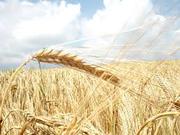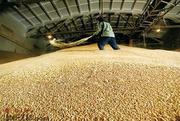News
Ukraine planted early spring grains throughout 583 thsd ha
As of March 18, 19 oblasts of Ukraine started the planting campaign of early spring grains. Agrarians planted grains throughout the areas of 583.2 thsd ha, or 23% of the plan, against 295 thsd ha, or 12% year ago, declared the Ministry of Agrarian Policy and Food of Ukraine.
- Read more
- 1809 reads
Agricultural commodities production decreased
In January-February 2016, the production volumes of agricultural commodities in Ukraine decreased by 2.1% compared with the same period in 2015 at the expense of fall of animal husbandry commodities, announced the State Statistics Service of Ukraine on March 14.
- Read more
- 1835 reads
Ukraine planted early spring grains throughout 217 thsd ha
As of March 11, fifteen oblasts of Ukraine started the planting campaign of early spring grains. Agrarians planted grains throughout the areas of 217 thsd ha, or 8% of the plan, declared the Ministry of Agrarian Policy and Food of Ukraine.
- Read more
- 1976 reads
Weak grain prices may be here to stay, warns EU
Weak grain prices are here to stay, potentially long-term, European Union officials said, as they forecast a further rise in the bloc's wheat inventories in 2016-17 despite weaker harvest prospects. Short term, "there are no fundamental reasons for [cereals] price levels to change," the European Commission said, citing large inventories.Grain stocks in the EU, the top wheat producer, and worldwide are "ample, and the moderate effect of El Niсo on markets is already incorporated in price expectations.
- Read more
- 1405 reads
Ukraine increase the spring crops planted areas by 1.7 mln ha
The planted areas under spring crops in Ukraine will increase by nearly 1.7 mln ha, which requires additional resources provision. Due to adverse weather conditions in the autumn, agrarians failed to plant winter grains throughout nearly 0.9 mln ha, and winter rapeseed throughout 237 thsd ha. In addition, the planted areas of almost 600 thsd ha did not receive sprouts at all, declared the First Deputy Minister of Agrarian Policy and Food of Ukraine, Yaroslav Krasnopolskiy on March 1.
- Read more
- 1736 reads
EU trade area promises new markets, but demands change
Ukraine’s hard-won Association Agreement with the European Union includes a free-trade deal that should open doors into markets long-closed to Ukrainian exporters. But to take advantage of the new opportunities, Ukraine’s exporters are going to have to make changes in marketing, business culture and production.
- Read more
- 1762 reads
Ukrainian wheat market - results of the first half of the season
Rather limited number of proposals of large-scale grain lots on the market, the unstable economic situation and devaluation of the national currency rates, became the key factors influencing on price formation in the market segment of wheat in the first half of 2015/16 MY. The current article focuses on some challenges faced by the market participants, price trends, and the prospects for further developments.
- Read more
- 1835 reads
In January, Ukraine reduced the exports of barley in 9 times
According to the official customs data, in January 2016 Ukraine exported 21.8 thsd tonnes of barley, as opposed to 200.4 thsd tonnes in December 2015. The major buyer of the Ukrainian grain - Saudi Arabia - significantly decreased its purchases (15 thsd tonnes in January 2016, against 88 thsd tonnes in the previous month), as well as Libya (7 thsd tonnes, against 37 thsd tonnes).
- Read more
- 1749 reads
The WTO’s decision to end agricultural export subsidies is good news
When I started to work in development cooperation in the late 1980s, one-third of EU agricultural subsidies—about 10 billion euros annually (equivalent to about 17 billion euros today)—were spent on export subsidies. The EU Common Agricultural Policy was a central planning system with administratively fixed intervention prices for major commodities, huge stocks of cereals and milk products, and high import tariffs.
- Read more
- 1844 reads
Prices too low to plant? Bank economist says no
Corn, bean, and wheat prices have all taken the plunge the past couple years, but analysts and traders said they’re optimistic that futures will improve in 2016. Corn futures on the Chicago Board of Trade have dropped 19% in the past two years, soybeans are down by a third, and wheat has dropped 24%.
- Read more
- 1994 reads

















